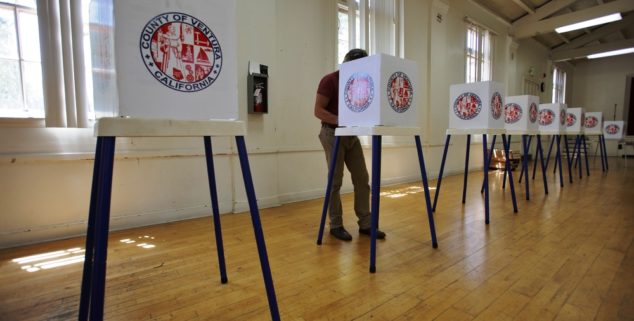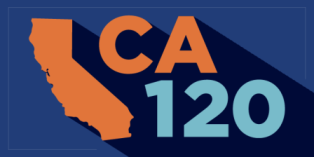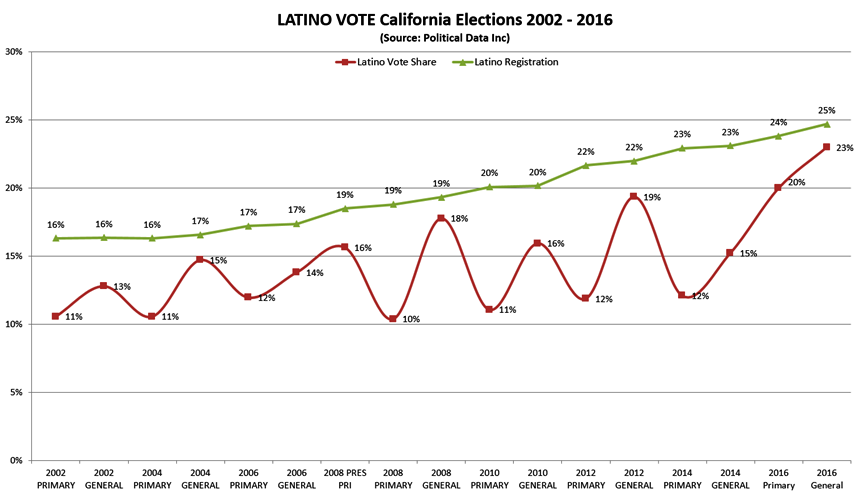News
CA120: High diversity, but low turnout looms in 2018
 A Ventura County voter casts a ballot in the June 2016 primary. (Photo: Joseph Sohm, via Shutterstock)
A Ventura County voter casts a ballot in the June 2016 primary. (Photo: Joseph Sohm, via Shutterstock)(Ed’s Note: This is the second of two parts examining the 2018 elections.)
Any sound voter analysis tries to identify prior events that hopefully serve to predict future voter behavior.
For this we examine several past elections, including the gubernatorial elections we mentioned in Part I, and other recent presidential primaries.
But each appears somewhat flawed as a predictor of what the 2018 primary will look like.
2016 Presidential Primary
This election has the benefit of being a very recent primary, with the most similar registered voter composition to what we expect to see in 2018. But the turnout was very lopsided. It was an intensely engaging primary for Democrats and a lackluster contest already decided for Republicans.
2014 Gubernatorial Primary
The most recent gubernatorial primary had one of the lowest turnouts for a statewide election in California’s history. It was even lower than the stand-alone June 2008 primary (after the February Presidential primary was held separately) or the 2009 statewide special election. This election gives us a potential floor for voter turnout, but might be well below the interest level in a race with an open and competitive governor’s race.
2010 Gubernatorial Primary
This election holds some of the characteristics we will see going into 2018 with open offices for governor, lieutenant governor, attorney general and controller, and a US Senate contest with an incumbent Democrat running for re-election. However, if you’re looking at the national political climate, this election was seen as a negative reaction to the first 18 months of the Obama Presidency, one which he described as a “shellacking.” Republicans gained 64 seats in the House and 20 state legislatures flipped from Democratic to Republican. If the working theory is that the 2018 election will be a negative reaction to the national party in power, as it was in 2010, then this election is going to present the opposite of what should be expected in terms of voter enthusiasm and motivation in each partisan base.
2002 Gubernatorial Primary
This contest was held on the heels of the tumultuous presidential election of 2000 in which George Bush was elected after a Florida recount gave him an Electoral College margin but loss of the popular vote. However, before the 2002 election the country rallied behind the President with a 9/11 increase in approval reaching a record high of 90%. Additionally, the primary in 2002 had a competitive race only on the Republican side with an embattled Governor Davis running virtually unopposed on the Democratic side.
1998 Gubernatorial Primary
Coming in the second mid-term election of Bill Clinton and in the midst of national scandal, this election did not have a particularly enthusiastic Democratic electorate, but it did have the most similar highly competitive and animated Democratic gubernatorial primary field with Davis, billionaire Al Checchi and Congresswoman Jane Harman, record political spending and significant media coverage.
The 1998 contest is likely the most recent similar election in terms of makeup of the candidates running statewide but there are no modern elections that have the combination of an open race for governor and the presence of a newly elected Republican administration as unpopular in California as is currently seen with the Trump administration.
Instead, we have to look at a blend of factors that consider the structural changes the state voter file has undergone in the last year, the trends of voter engagement as a response to a new national administration in power, and the rates of participation among voters, particularly younger and independent voters, Latinos and other minority voters who have not historically participated in primaries.
Latino Vote and Challenges
For the past two decades Latinos have continued to grow as a share of the registered voter population. At 38% of all Californians, they are a plurality of the state’s population.
However, among registered voters they come in at 24.7%, or approximately a quarter of the registered population. And as a share of the voters who actually cast ballots, they can fluctuate between a high of 23% of the votes cast in the November general, to nearly half that in the last gubernatorial primary where they were just 12% of all votes cast.
There have actually been just two contests in the past 20 years in which the Latino share of the votes cast on Election Day was greater than their overall registration rate.
One was in the 2005 LA municipal election when Antonio Villaraigosa won with help from an energized Latino electorate that reflected 26% of all votes cast, despite being just 21% of the registered voter population.
The other was in 2004 when then-Assembly Candidate Kevin De Leon won in a primary against Christine Chavez, granddaughter of Cesar Chavez.
Aside from these two instances, in every statewide or major municipal election, including thousands of legislative and congressional races going back dozens of years, Latinos have underperformed in comparison with their rate of registration.
This underperformance is greatest in primaries where Latino turnout has dipped in every election aside from the 2016 presidential primary. In the past four gubernatorial primaries Latino turnout has been between 11-12% of votes cast.
As the following shows, the registration rate for Latinos has been on a constant gradual upswing since 2002, but their share of votes cast have wildly fluctuated.

There is no doubt that the Latino share of the electorate will grow in the coming 18 months to well over one-quarter of the total registered voter population, but the real question is about their turnout and ultimate share of voters who cast ballots in a primary.
Aside from the 2016 primary, which was an outlier, their performance in primaries has been at about 55% of their actual strength in terms of registration.
The Most Diverse California Ballot in History
While many in the media and political circles are discussing the possibility that Latino turnout will grow as a function of the Antonio Villaraigosa’s potential to be the first Latino elected governor in California, a look at the current declared and likely candidates shows something even more interesting: California’s ballot could be the most diverse ever.
Front runners, those with the most financial and political support, combined with incumbents, shows Latinos have significant candidates in the top tier of five of the eight statewide contests on the ballot.
Here are the Latinos on the 2018 primary election ballot:
–Former LA Mayor Antonio Villaraigosa, governor
–State Sen. Ed Hernandez, Lt. Governor
–Secretary of State Alex Padilla (re-election)
–Attorney General Xavier Becerra (incumbent appointee, election)
–State Sen. Ricardo Lara, Insurance Commissioner
The state has obviously had prominent Latinos as significant candidates on the ballot before, including Alex Padilla winning in his first SOS election in 2014. Others include Loretta Sanchez for the US Senate, Rocky Delgadillo for attorney general, John Perez for state controller and Gloria Romero for superintendent of public instruction.
But having five Latinos as top-tier statewide candidates, including two incumbents, is unprecedented.
This presence of several major Latino candidates on the same ballot means that California voters will for the first time see an election where the majority of political mailers, commercials, and media coverage will be focused on campaigns for Latinos.
Additionally, the state will see the first major Asian gubernatorial candidate in John Chiang, who has historically been a top vote getter and has appeared on the statewide ballot 10 times, along with Betty Yee running for re-election as state controller and Fiona Ma coming in as a top-tier candidate for state treasurer.
These campaigns have the potential to provide a cumulative benefit in terms of Latino and Asian turnout, or they could create a challenging perception issue for white voters who will still be the vast majority of voters who participate.
Projecting the Electorate
While this remains a moving target, some preliminary work with the California voter file makes it possible to construct a basic likely voter universe for the 2018 primary and general.
This is currently based on a rather healthy turnout rate of between 38% to 40%, which would put participation in this primary well above the 25% in the 2014 election, but below the 1990 and 1998 cycles.
Within this range of turnout about half of the electorate would be Democratic. Republicans, currently just under 26% of the voter file, would account for about a third of ballots cast, with the remainder cominging from independent and other minor-party voters.
Composition of Likely Primary Election Voters
| 2014 Primary | 2016 Primary | 2018 Primary Universe A | 2018 Primary Universe B | |
| Turnout | 25% | 47% | 38% | 40% |
| Dem | 45% | 52% | 48% | 49% |
| Rep | 36% | 29% | 33% | 32% |
| Other | 19% | 19% | 18% | 19% |
| Latino | 12% | 20% | 16% | 17% |
| Age over 65 | 43% | 32% | 39% | 37% |
One group to significantly out-perform in these likely voter universes would be seniors – currently at just 22% of the electorate, but expected to be nearly 40% of votes cast. Conversely, Latinos, even with their continued growth in the voter file are projected to be only 16%-17% of votes cast – representing a loss of a third of their voting power.
An accurate voter landscape for the general election in 2018 won’t be constructed until after the primary. But a close look at current election history suggests a higher overall turnout than in the 2014 general, more consistent with other November elections with an open governor’s race and competitive down-ticket contests.
Composition of Likely General Election Voters
| 2014 General | 2016 General | 2018 Primary Universe A | 2018 Primary Universe B | |
| Turnout | 47% | 74% | 59% | 60% |
| Dem | 44% | 46% | 48% | 48% |
| Rep | 34% | 28% | 30% | 29% |
| Other | 22% | 26% | 22% | 23% |
| Latino | 15% | 23% | 20% | 20% |
| Age over 65 | 43% | 24% | 30% | 30% |
The real impact of these numbers can be seen at the district-level. Several contests that looked extremely competitive in the 2016 Primary and General would be less so in projected likely voter universes for the coming cycle. Looking just at the Congressional districts that are considered competitive, each sees significant shifts based on the comparison of what happened in 2016 and projected turnout for 2018.
Congressional Partisan Advantage Projections
| District | Member | Historic 2016 | Projected 2018 | ||
| Primary | General | Primary | General | ||
| 10TH | Jeff Denham (R) | DEM + 2% | DEM + 4% | REP + 3% | DEM + 2% |
| 21ST | David Valadao (R) | DEM + 17% | DEM + 11% | DEM + 5% | DEM + 12% |
| 25TH | Pete Knight (R) | DEM + 3% | DEM + 3% | REP + 10% | REP + 2% |
| 39TH | Ed Royce (R) | REP + 2% | REP + 1% | REP + 12% | REP + 5% |
| 45TH | Mimi Walters (R) | REP + 9% | REP + 9% | REP + 19% | REP + 13% |
| 49TH | Darrell Issa (R) | REP + 7% | REP + 3% | REP + 11% | REP + 8% |
On average, each district gets nine points more Republican for the primary and three points more Republican for the general election. The Valadao seat appears to be strongly Democratic going into the coming election, but not as much when considering that he was able to win in a very similar environment in 2016. If registration gains in the coming 18 months don’t eat into these numbers then they should be safer than they were in 2016.
Looking for Signals
Between now and the 2018 primary, there are not many events that will provide insight into the potential turnout of these voters who were intensely motivated in 2016.
We can, however, look for signals in the Los Angeles County elections in March and May of this year, the special election for Xavier Becerra’s 34th Congressional District, and possibly a special election in the 51st Assembly District if Assemblyman Jimmy Gomez is successful in his congressional bid.
The LA City elections are historically very low turnout. As of this writing, the number of votes cast is somewhere between the turnouts in 2013 and 2015 cycles, representing about 15% of the registered voters and a fraction of the voters who turned out for the 2016 general election.
If late ballots account for a higher LA turnout, or if turnout spikes in the congressional special election in April, then we might have evidence that voters are making a connection between their heightened awareness of politics at the national level and their engagement in local and state elections.
But if turnout is as low as in prior elections, despite the seemingly hyper-charged political atmosphere, then one could expect that the 2018 election cycle will look more like a traditional gubernatorial primary.
This all could change based on national events, or if issues are added to the ballot that drive voter turnout in unexpected ways.
One example that has been brought up is Proposition 71, the 2004 stem cell measure placed on the ballot as a reaction to then-President George W. Bush’s efforts to limit this research at a national level.
While this was a substantive issue, part of the appeal for California voters was it represented a rejection of a Bush policy. In the same vein, the recently passed Proposition 59 opposing Citizens United court decision on campaign spending, does not actually change state policy. Instead, it uses a ballot initiative to send a message about campaign finance reform to Washington, D.C and the Supreme Court.
If the California Legislature or voters approved measures to combat the Trump agenda on any of the hot-button issues such as immigration, abortion, border security, or even international interference in elections, this could serve as a catalyst for turnout and “nationalize” the statewide elections.
Like the non-binding Citizen’s United measure, these might not even need the force of law, but simply send a message.
Based on current state law, any measure on the ballot for June 2018 would have to be drafted by the Legislature, but a citizen-generated measure for the November election could be seen as a likely move by organizations that want to ensure a high voter turnout and make the election a referendum on the Trump presidency.
—
Ed’s Note: Paul Mitchell, a veteran political strategist and a regular contributor to Capitol Weekly, is the founder of the CA120 column and the vice president of Political Data, which markets information to campaigns in both major parties.
Want to see more stories like this? Sign up for The Roundup, the free daily newsletter about California politics from the editors of Capitol Weekly. Stay up to date on the news you need to know.
Sign up below, then look for a confirmation email in your inbox.

Leave a Reply